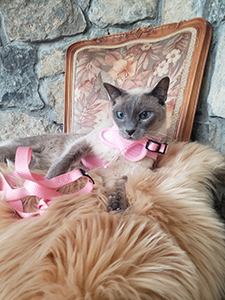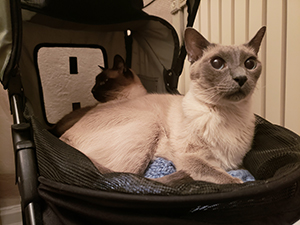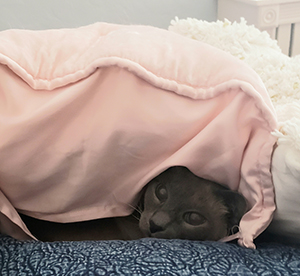Flying with Cats? Follow these Tips for Purrfect Domestic Travel
By Arielle Bennett and Dr. Eric Dougherty, DVM
Flying with a cat is not necessarily the easiest undertaking, and as airlines shrink our few inches of legroom, cats also lose their allotted space on a plane. If you’ve noticed your cat was stressed in their carrier before, the airline experience will be exponentially more difficult because traveling to the airport is dreary for us humans too. Now that I’ve been running a feline veterinary practice in Manhattan with my spouse for several years (thecatpractice.com), my clients often ask what they should do about traveling with their cats. When I moved across country from one coast to the other with my cat I had no idea how challenging it was going to be throughout the trip. The good news is that most cats are relatively well behaved in-flight, but in my experience flying with one of my cats, I would rather drive across the country and stop every few hours than put us through air travel again.
 Phil finally feeling more like himself in his harness
Phil finally feeling more like himself in his harnessCATS ON A PLANE
Explore your travel options and put your cat’s needs first. Before flying with your cat, first consider whether this is a trip of necessity (like a move), how long the trip is, what kind of temperament your cat has, and whether you have any alternatives. Some people might think seeing relatives out of state would be fun with their cat, but honestly your cat would be happier at home with a sitter or being boarded in a cat-friendly environment.
I genuinely thought my cat would do well on a plane based on his fantastic temperament at home, but he literally chewed out of his carrier on-the-plane, meowed the entire time, and peed on himself. No matter what I did he never calmed down, and I would’ve done anything to have helped him feel better about the trip. Luckily he had a harness and I was able to hold him as the kind flight attendant duct taped the carrier back together. Flying can be very stressful for a cat that will likely have nowhere to walk, eat/drink, or use the restroom, which is why traveling with cats in planes should only be done out of absolute necessity.
Plan ahead and pick your airline strategically. Airlines are not equally pet-friendly and have different pet travel fees and rules (such as for carrier size and even the size/breed of your cat), and many do not allow more than one per passenger. Depending on the airline, pets are not necessarily guaranteed a spot if you book online, and some airlines will not let you move your cat from under the seat. While domestic travel with cats is much easier than international, check your airline’s policies and make sure to call ahead to book your flight and ask questions.
If you are able to purchase an aisle seat, extra legroom, and/or an expedited check-in or security line, it could be helpful as well. If possible, non-stop flights would be preferable for kitty to arrive at the destination sooner. Even if your cat is an emotional support animal and you may have more flexibility on the plane, several airlines have made increasing restrictions for them. There are agencies that specialize in transporting pets, but your cat may fly in the cargo area and could be left unattended for hours and have a longer trip than if they flew with you, so check reviews and thoroughly research how they will keep your cat safe.
 Phil enjoying his travel stroller that doubles as one of his house beds
Phil enjoying his travel stroller that doubles as one of his house bedsASK THE VET
Visit your vet. Always make sure your cat is healthy and microchipped before any travel. Cats can usually be given domestic health certificates for travel by their veterinarian in a simple office visit (some airlines have their own form and timeline for certificates, so check their guidance). Many of our clients ask us about sedation, but if something goes wrong you won’t be able to get your cat medical attention, so sedation isn’t often recommended. There are alternatives such as anti-anxiety medicines that may be used in stressful travel times, but be sure your veterinarian gives you the approval, and also give your cat a trial run on the medicine at home beforehand to ensure there are no negative side effects.
KITTY TRAVEL TIPS
Keep your cat as safe and comfortable as you can while flying. Your kitty’s needs on the flight are imperative, yet your options for comfort will be limited. Help your cat learn to walk with a harness and leash well before the trip, and keep the carrier you’re using out so your cat gets used to it in a positive way. Attract them to it with treats, catnip, and toys so they’ll feel safer on the big day. It’s useful for cats to experience their carriers more than just going to the vet, so take them on a few short outings and reward them greatly. Before you leave for the airport, use catnip and calming pheromone sprays in the carrier, and bring something breathable to cover part of it so your cat won’t see all the chaos around them. An unwashed shirt with your smell is good to use as bedding, and even include a favorite soft toy.

While it might not be cozy for your cat to be in a harness, you will have to take them out of the carrier for the security screening. I was able to hold my cat through the metal detector, but I wouldn’t count on being allowed to. Find out in advance if there is a designated pet zone in your airport or airline lounge that you can use before flying. Once you’re in the air, talk to the flight attendant and see if they will be easygoing and hopefully let you keep your carrier on your lap after takeoff.
If you can offer your cat water that is also important, though it might be difficult to find a way to do so. For long flights your cat will likely need to go to the bathroom, but given the small-sized carriers that planes allow, your cat may be quite messy when you land. If you can bring a change of bedding or disposable pad and wipes, it may come in handy. Throughout the flight, talk to your cat and use tones of comfort, patience, and reassurance. Remember, your cat might need a few days to adjust once you two make it to your destination, but we know that bringing her with you was well worth it!
Arielle Bennett and Dr. Eric Dougherty, DVM are The Cat Practice, veterinarians just for cats. For more information, go to thecatpractice.com.















